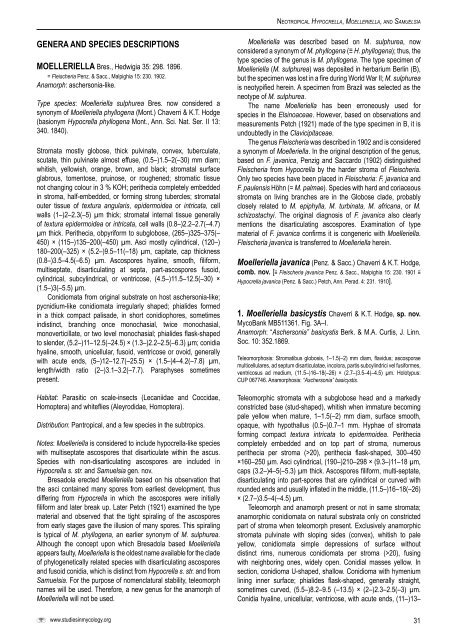Moelleriella, and Samuelsia - CBS
Moelleriella, and Samuelsia - CBS
Moelleriella, and Samuelsia - CBS
- No tags were found...
You also want an ePaper? Increase the reach of your titles
YUMPU automatically turns print PDFs into web optimized ePapers that Google loves.
Ne o t r o p i c a l Hy p o c r e l l a, Mo e l l e r i e l l a, a n d Sa m u e l s i aGenera <strong>and</strong> Species descriptionsMOELLERIELLA Bres., Hedwigia 35: 298. 1896.= Fleischeria Penz. & Sacc., Malpighia 15: 230. 1902.Anamorph: aschersonia-like.Type species: <strong>Moelleriella</strong> sulphurea Bres. now considered asynonym of <strong>Moelleriella</strong> phyllogena (Mont.) Chaverri & K.T. Hodge(basionym Hypocrella phyllogena Mont., Ann. Sci. Nat. Ser. II 13:340. 1840).Stromata mostly globose, thick pulvinate, convex, tuberculate,scutate, thin pulvinate almost effuse, (0.5–)1.5–2(–30) mm diam;whitish, yellowish, orange, brown, <strong>and</strong> black; stromatal surfaceglabrous, tomentose, pruinose, or roughened; stromatic tissuenot changing colour in 3 % KOH; perithecia completely embeddedin stroma, half-embedded, or forming strong tubercles; stromatalouter tissue of textura angularis, epidermoidea or intricata, cellwalls (1–)2–2.3(–5) µm thick; stromatal internal tissue generallyof textura epidermoidea or intricata, cell walls (0.8–)2.2–2.7(–4.7)µm thick. Perithecia, obpyriform to subglobose, (265–)325–375(–450) × (115–)135–200(–450) µm. Asci mostly cylindrical, (120–)180–200(–325) × (5.2–)9.5–11(–18) µm, capitate, cap thickness(0.8–)3.5–4.5(–6.5) µm. Ascospores hyaline, smooth, filiform,multiseptate, disarticulating at septa, part-ascospores fusoid,cylindrical, subcylindrical, or ventricose, (4.5–)11.5–12.5(–30) ×(1.5–)3(–5.5) µm.Conidiomata from original substrate on host aschersonia-like;pycnidium-like conidiomata irregularly shaped; phialides formedin a thick compact palisade, in short conidiophores, sometimesindistinct, branching once monochasial, twice monochasial,monoverticillate, or two level monochasial; phialides flask-shapedto slender, (5.2–)11–12.5(–24.5) × (1.3–)2.2–2.5(–6.3) µm; conidiahyaline, smooth, unicellular, fusoid, ventricose or ovoid, generallywith acute ends, (5–)12–12.7(–25.5) × (1.5–)4–4.2(–7.8) µm,length/width ratio (2–)3.1–3.2(–7.7). Paraphyses sometimespresent.Habitat: Parasitic on scale-insects (Lecaniidae <strong>and</strong> Coccidae,Homoptera) <strong>and</strong> whiteflies (Aleyrodidae, Homoptera).Distribution: Pantropical, <strong>and</strong> a few species in the subtropics.Notes: <strong>Moelleriella</strong> is considered to include hypocrella-like specieswith multiseptate ascospores that disarticulate within the ascus.Species with non-disarticulating ascospores are included inHypocrella s. str. <strong>and</strong> <strong>Samuelsia</strong> gen. nov.Bresadola erected <strong>Moelleriella</strong> based on his observation thatthe asci contained many spores from earliest development, thusdiffering from Hypocrella in which the ascospores were initiallyfiliform <strong>and</strong> later break up. Later Petch (1921) examined the typematerial <strong>and</strong> observed that the tight spiraling of the ascosporesfrom early stages gave the illusion of many spores. This spiralingis typical of M. phyllogena, an earlier synonym of M. sulphurea.Although the concept upon which Bresadola based <strong>Moelleriella</strong>appears faulty, <strong>Moelleriella</strong> is the oldest name available for the cladeof phylogenetically related species with disarticulating ascospores<strong>and</strong> fusoid conidia, which is distinct from Hypocrella s. str. <strong>and</strong> from<strong>Samuelsia</strong>. For the purpose of nomenclatural stability, teleomorphnames will be used. Therefore, a new genus for the anamorph of<strong>Moelleriella</strong> will not be used.www.studiesinmycology.org<strong>Moelleriella</strong> was described based on M. sulphurea, nowconsidered a synonym of M. phyllogena (≡ H. phyllogena); thus, thetype species of the genus is M. phyllogena. The type specimen of<strong>Moelleriella</strong> (M. sulphurea) was deposited in herbarium Berlin (B),but the specimen was lost in a fire during World War II; M. sulphureais neotypified herein. A specimen from Brazil was selected as theneotype of M. sulphurea.The name <strong>Moelleriella</strong> has been erroneously used forspecies in the Elsinoaceae. However, based on observations <strong>and</strong>measurements Petch (1921) made of the type specimen in B, it isundoubtedly in the Clavicipitaceae.The genus Fleischeria was described in 1902 <strong>and</strong> is considereda synonym of <strong>Moelleriella</strong>. In the original description of the genus,based on F. javanica, Penzig <strong>and</strong> Saccardo (1902) distinguishedFleischeria from Hypocrella by the harder stroma of Fleischeria.Only two species have been placed in Fleischeria: F. javanica <strong>and</strong>F. paulensis Höhn (= M. palmae). Species with hard <strong>and</strong> coriaceousstromata on living branches are in the Globose clade, probablyclosely related to M. epiphylla, M. turbinata, M. africana, or M.schizostachyi. The original diagnosis of F. javanica also clearlymentions the disarticulating ascospores. Examination of typematerial of F. javanica confirms it is congeneric with <strong>Moelleriella</strong>.Fleischeria javanica is transferred to <strong>Moelleriella</strong> herein.<strong>Moelleriella</strong> javanica (Penz. & Sacc.) Chaverri & K.T. Hodge,comb. nov. [≡ Fleischeria javanica Penz. & Sacc., Malpighia 15: 230. 1901 ≡Hypocrella javanica (Penz. & Sacc.) Petch, Ann. Perad. 4: 231. 1910].1. <strong>Moelleriella</strong> basicystis Chaverri & K.T. Hodge, sp. nov.MycoBank MB511361. Fig. 3A–I.Anamorph: “Aschersonia” basicystis Berk. & M.A. Curtis, J. Linn.Soc. 10: 352.1869.Teleomorphosis: Stromatibus globosis, 1–1.5(–2) mm diam, flavidus; ascosporaemulticellulares, ad septum disarticulatae, incolora, partis subcylindrici vel fusiformes,ventricosus ad medium, (11.5–)16–18(–26) × (2.7–)3.5–4(–4.5) µm. Holotypus:CUP 067746. Anamorphosis: “Aschersonia” basicystis.Teleomorphic stromata with a subglobose head <strong>and</strong> a markedlyconstricted base (stud-shaped), whitish when immature becomingpale yellow when mature, 1–1.5(–2) mm diam, surface smooth,opaque, with hypothallus (0.5–)0.7–1 mm. Hyphae of stromataforming compact textura intricata to epidermoidea. Peritheciacompletely embedded <strong>and</strong> on top part of stroma, numerousperithecia per stroma (>20), perithecia flask-shaped, 300–450×160–250 µm. Asci cylindrical, (190–)210–298 × (9.3–)11–18 µm,caps (3.2–)4–5(–5.3) µm thick. Ascospores filiform, multi-septate,disarticulating into part-spores that are cylindrical or curved withrounded ends <strong>and</strong> usually inflated in the middle, (11.5–)16–18(–26)× (2.7–)3.5–4(–4.5) µm.Teleomorph <strong>and</strong> anamorph present or not in same stromata;anamorphic conidiomata on natural substrata only on constrictedpart of stroma when teleomorph present. Exclusively anamorphicstromata pulvinate with sloping sides (convex), whitish to paleyellow, conidiomata simple depressions of surface withoutdistinct rims, numerous conidiomata per stroma (>20), fusingwith neighboring ones, widely open. Conidial masses yellow. Insection, conidioma U-shaped, shallow. Conidioma with hymeniumlining inner surface; phialides flask-shaped, generally straight,sometimes curved, (5.5–)8.2–9.5 (–13.5) × (2–)2.3–2.5(–3) µm.Conidia hyaline, unicellular, ventricose, with acute ends, (11–)13–31
















